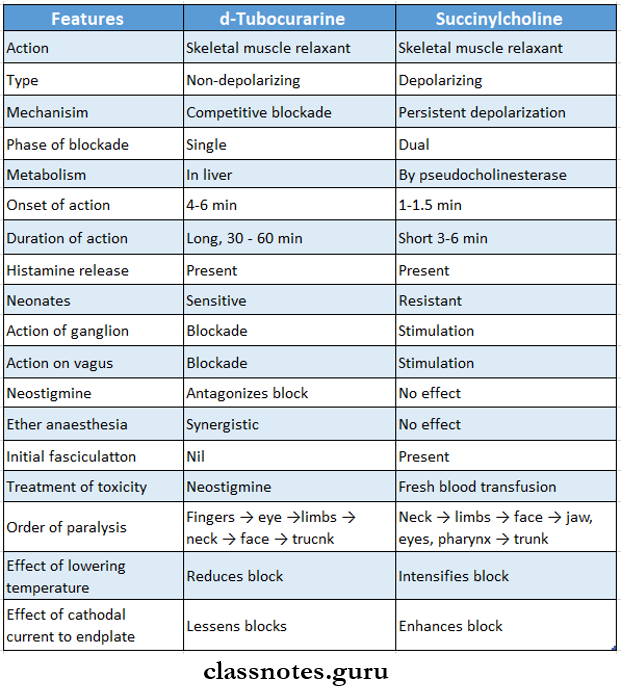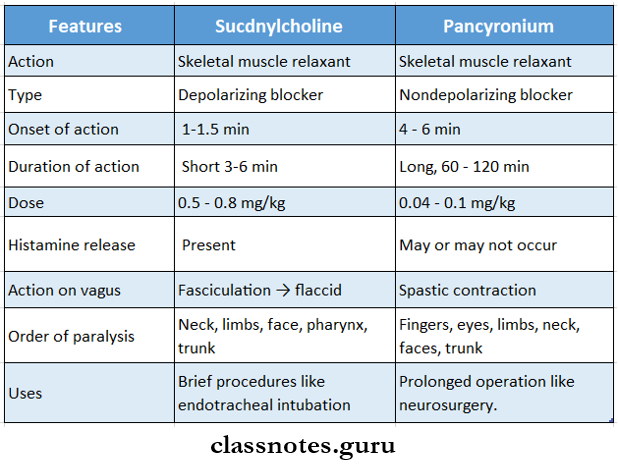Skeletal Muscle Relaxants Important Notes
1. Skeletal Muscle Relaxants Classification
- Drugs acting centrally
- Diazepam, Baclofen
- Drugs acting peripherally at the neuromuscular junction
- Competitive blockers
- D-tubocurarine, Pancuronium, Rocuronium
- Competitive blockers
- Depolarising blockers
- Succinylcholine
- Drugs acting directly on muscle
- Dantrolene
Read And Learn More: Pharmacology Question and Answers
2. Succinylcholine
- It is depolarizing peripherally acting muscle relaxant
- Induces rapid, complete, and predictable paralysis with spontaneous recovery
- The onset of action – 1-1.5 min
- Adverse drug reactions
- Post-operative muscel pain
- Hyperkalaemia
- Cardiac arrhythmias
- Malignant hyperthermia
3. Non-depolarizing muscle relaxant
- Long acting – d-tubocurarine, Pancuronium
- Intermediate-acting – vecuronium, atracurium
- Short-acting – mivacurium
4. Tubocurarine
- Releases histamine from mast cells
- This contributes to hypertension, flushing, and bronchospasm
- Tubocurarine is administered 4
- In case of poisoning, neostigmine is used
Skeletal muscle relaxant pharmacology
Skeletal Muscle Relaxants Long Essays
Question 1. Classify skeletal muscle relaxants. Describe the pharmacological actions, therapeutic uses, and adverse effects of d-tubocurarine.
or
List two classes of skeletal muscle relaxants acting at the neuromuscular junction. Mention two therapeutic uses of peripheral-acting muscle relaxants.
Answer:
Skeletal muscle relaxants:
- Skeletal muscle relaxants are drugs that act peripherally at the neuromuscular junction or muscle fiber itself or centrally in the cerebrospinal axis to reduce muscle tone and/or cause paralysis.
Skeletal muscle relaxants Classification:
1. Peripherally acting muscle relaxants.
- Neuromuscular blocking agents.
- Non-depolarizing blockers.
- Long acting – d-tubocurarine, pancuronium.
- Intermediate-acting – vecuronium, atracurium
- Short-acting – mivacurium.
- Depolarizing blockers.
- Succinylcholine, Decamethonium
- Non-depolarizing blockers.
2. Directly acting agents.
- Dantrolene sodium, Quinine.
3. Centrally acting agents.
- Mephenesin congeners- Mephenesin, carisoprodol.
- Benzodiazepines – Diazepam.
- GABA derivatives – baclofen.
- Central α2 agonist – Tizanidine.
4. Tubocurarine:
It is a peripherally acting, non-depolarizing skeletal muscle relaxant.
Pharmacological Actions:
1. Skeletal muscle.
- Intravenous injection initially causes muscular weakness followed by flaccid paralysis.
- It acts at the neuromuscular junction preventing the combination of acetylcholine released from the motor never ending with its receptors.
2. CVS
- Causes hypotension.
3. Histamine – causes its release.
4. Autonomic ganglia.
- In high doses, blocks the autonomic ganglia and adrenal medulla resulting in hypotension.
5. GIT
- Enhances postoperative paralytic ileus after abdominal operations.
Skeletal muscle relaxants Uses:
- As an adjuvant to general anesthesia.
- In dentistry for setting mandibular fractures.
- Assisted ventilation of critically ill patients in the ICU.
- To avoid convulsions and trauma from electroconvulsive therapy.
- In severe cases of tetanus and status epilepticus.
Skeletal muscle relaxants Adverse Effects:
- Respiratory paralysis and prolonged apnea.
- Flushing
- Hypotension and cardiovascular collapse.
- Precipitation of asthma with histamine release.
Skeletal Muscle Relaxants Short Essays
Question 1. Compare d-tubocurarine and succinylcholine.
Answer:

Skeletal muscle relaxants classification
Question 2. Compare succinylcholine and pancuronium.
Answer:

Question 3. Describe the uses of centrally and peripherally acting skeletal muscle relaxants.
Answer:
Uses of centrally acting skeletal muscle relaxants:
- During acute muscle spasms, it is used along with anal¬gesics.
- Used to cure torticollis, backache, and neuralgia.
- Used to relieve anxiety and tension.
- Used in spastic neurological disorders like hemiplegia, and paraplegia.
- During tetanus IV diazepam is given.
- During electroconvulsive therapy, diazepam is used to suppress convulsions.
- Used in orthopedic surgery like mandibular fractures.
Uses of peripherally acting skeletal muscle relaxant:
- As an adjuvant to general anesthesia.
- To promote skeletal muscle relaxation during abdominal surgery.
- In dentistry to treat the mandibular fracture.
- Used in severe cases of tetanus and status epilepticus.
- Useful in laryngoscopy, bronchoscopy esophagoscopy, and tracheal intubation.
- To facilitate artificial ventilation of critically ill patients in the ICU.
Question 4. Succinylcholine.
Answer:
Succinylcholine is a peripherally acting skeletal muscle relaxant.
- It is depolarizing neuromuscular blocking agent
Succinylcholine Mechanism of action:
Succinylcholine
↓
Stimulation of nicotinic receptors
↓
Depolarization of skeletal muscle membrane.
↓
Persistent depolarization.
↓
Results In flaccid paralysis
- This Is PHASE – 1 block.
- At high doses, dual block occurs.
Phase -1 block
↓
Initial depolarization
↓
Phase – 2 Nondepolarizing block.
Succinylcholine Adverse Effects:
- Increases intraocular pressure.
- Postoperative muscle pain – common
- Hyperkalemia.
- Cardiac arrhythmia.
- Apnea.
- Malignant hyperthermia – genetically determined
Skeletal Muscle Relaxants Short Answers
Question 1. Pancuronium.
Answer:
Pancuronium is a peripherally acting skeletal muscle relaxant
- It is a long-acting, non-depolarizing competitive neuro-muscular blocking agent
Pancuronium Uses:
- As an adjuvant to general anesthesia.
- Used to promote skeletal muscle relaxation during abdominal surgery.
- Used in the treatment of mandibular fractures.
- In severe cases of tetanus and status epilepticus.
- Duration of action – 60 – 120 min.
- The onset of action – 4 – 6 min.
- Dose – 0.04 – 0.1 mg/kg of body weight
Skeletal muscle relaxants drugs list
Question 2. Lioresal.
Answer:
It is the trad$ name of baclofen, which is an analog of the inhibitory transmitter GABA.
Lioresal Mechanism:
- The primary site of action is the spinal cord.
- It depresses poly-synaptic and mono-synaptic reflexes.
Lioresal Uses:
- Reduces spasticity in neurological disorders like multiple sclerosis.
- Improves bladder and bowel functions in patients with spinal lesions.
- Tried in trigeminal neuralgia.
Lioresal Adverse effects:
- Drowsiness, weakness, ataxia,
- Abrupt withdrawal causes anxiety, palpitation, and hallucinations.
- Dose: 10 mg BD to 25 mg TDS
Viva Voce:
1. Diaphragm is most resistant to succinylcholine
